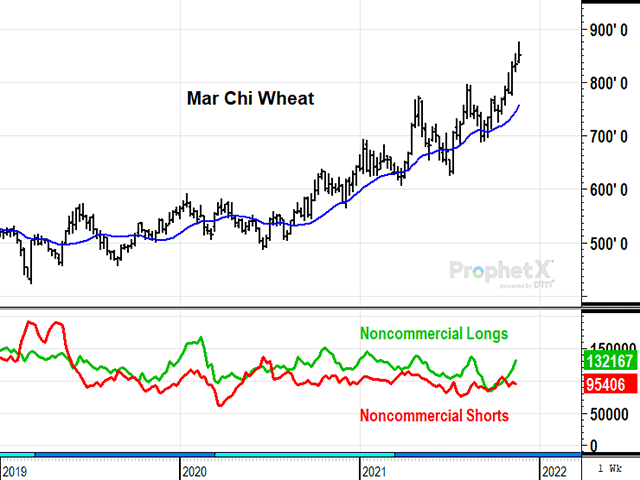Todd's Take
A Hint of Panic in the Wheat Market?
The recent rally in wheat prices received new attention this week after the March contracts of both Kansas City and Chicago wheat jumped to new contract highs Tuesday, the highest closes for both March contracts in eight years. As you have probably heard by now, USDA's estimate of U.S. ending wheat stocks is 583 million bushels (mb) for 2021-22, the lowest in 14 years. USDA's estimate of ending wheat stocks at the top eight exporters is 1.78 billion bushels (bb), also the lowest in 14 years.
The last time both U.S. and world supplies were this tight was 2007-08, when U.S. ending stocks were estimated at 306 mb and the top exporters' ending supplies totaled 1.45 bb. With world wheat demand estimated at 22.68 bb in 2007-08, exporters' supplies represented a mere 6% of annual use, roughly the same slim ratio as today.
Of course, we would all like to know how high wheat prices are going, but as I've explained before, picking tops in markets where supplies are tight is the most difficult challenge any analyst faces. Markets aren't mathematically predictable like computers. Markets are people and people get emotional. We saw plenty of examples of that in corn and soybeans earlier this year. Weather is also a highly uncertain variable that has a lot to say about grain prices.
We can consider the 2007-08 season as a rough guide for what to expect. Thirteen years ago, crude oil was $100 and rising. The U.S. had passed two ethanol mandates and corn prices were breaking new highs, the start of the ethanol boom for corn.
Today's crude oil is below $80, but it is interesting that biofuels have become more popular again as national gasoline prices have jumped up to $3.40 a gallon, similar to where they were in early 2008. Once again, we have a tightening of global food supplies at the same time grains are being called upon to help stretch the world's energy supplies.
In February 2008, spot Chicago wheat peaked at $13.38 per bushel, but the speculative frenzy that took prices well above $10 did not last long. By the end of March, prices were back down to $9.29 per bushel and spot Chicago wheat has not been back to $10 since.
P[L1] D[0x0] M[300x250] OOP[F] ADUNIT[] T[]
Could a similar buying frenzy erupt sometime this winter?
Yes, looking at wheat's fundamentals and the noncommercial positions in Chicago wheat, I have to say a buying frenzy is quite possible. As explained, supplies are tight enough.
This month's rally in wheat has been propelled by drought in the southwestern U.S. Plains and by excessive rain in eastern Australia, hurting wheat's prospects at harvest time. As DTN Contributing Analyst Tregg Cronin mentioned in his early word grains commentary on Nov. 24, the next significant wheat crops after Australia and Argentina won't arrive until May or June 2022. Stay tuned as weather will be a big factor for wheat in early 2022.
Looking at the CFTC's most recent rundown of speculative positions in Chicago wheat, two things stand out: First, for a market trading at its highest prices in eight years, 132,167 contracts on the long side of Chicago wheat isn't much of a position. It is clear that wheat prices have earned their way to these prices by legitimate commercial demand for tight supplies.
Secondly, with Chicago wheat trading well above $8.00, speculators are holding 95,406 contracts short. Clearly, somebody has been asleep at the wheel as we have heard about drought and reduced world supplies for many months. The typical speculator is a trend-following managed futures fund and, had they been paying attention at all, they would have been out long before now. Keep in mind, the speculator is not like a commercial that's holding offsetting cash positions.
By my calculation, specs have lost roughly $550 million by being short Chicago wheat the past two months. For those lost souls, that's not the worst of it. The worst of it is that as much as they need to get out, they are likely going to drive the market higher. It's not like a new crop is on its way to save them.
With winter wheat prices at their highest level in eight years, it would be understandable for producers to have sold 2021 production by now, and given the nature of market uncertainty, there is no reason to fault them. As usual, I can't guarantee anything, but for any that are still hanging on to this year's wheat, you should know that there are 95,000 reasons to suspect prices could get a little crazy this winter.
Continue this conversation in person at this year's DTN Ag Summit in Chicago on Dec. 5 to 7. I will be there, talking about the challenges of markets in 2022. Even better, we have several distinguished speakers, covering lots of important topics for your farm. Find out more and register at www.dtn.com/agsummit/.
**
Comments above are for educational purposes only and are not meant as specific trade recommendations. The buying and selling of grain or grain futures or options involve substantial risk and are not suitable for everyone.
Todd Hultman can be reached at Todd.Hultman@dtn.com
Follow him on Twitter @ToddHultman1
(c) Copyright 2021 DTN, LLC. All rights reserved.




